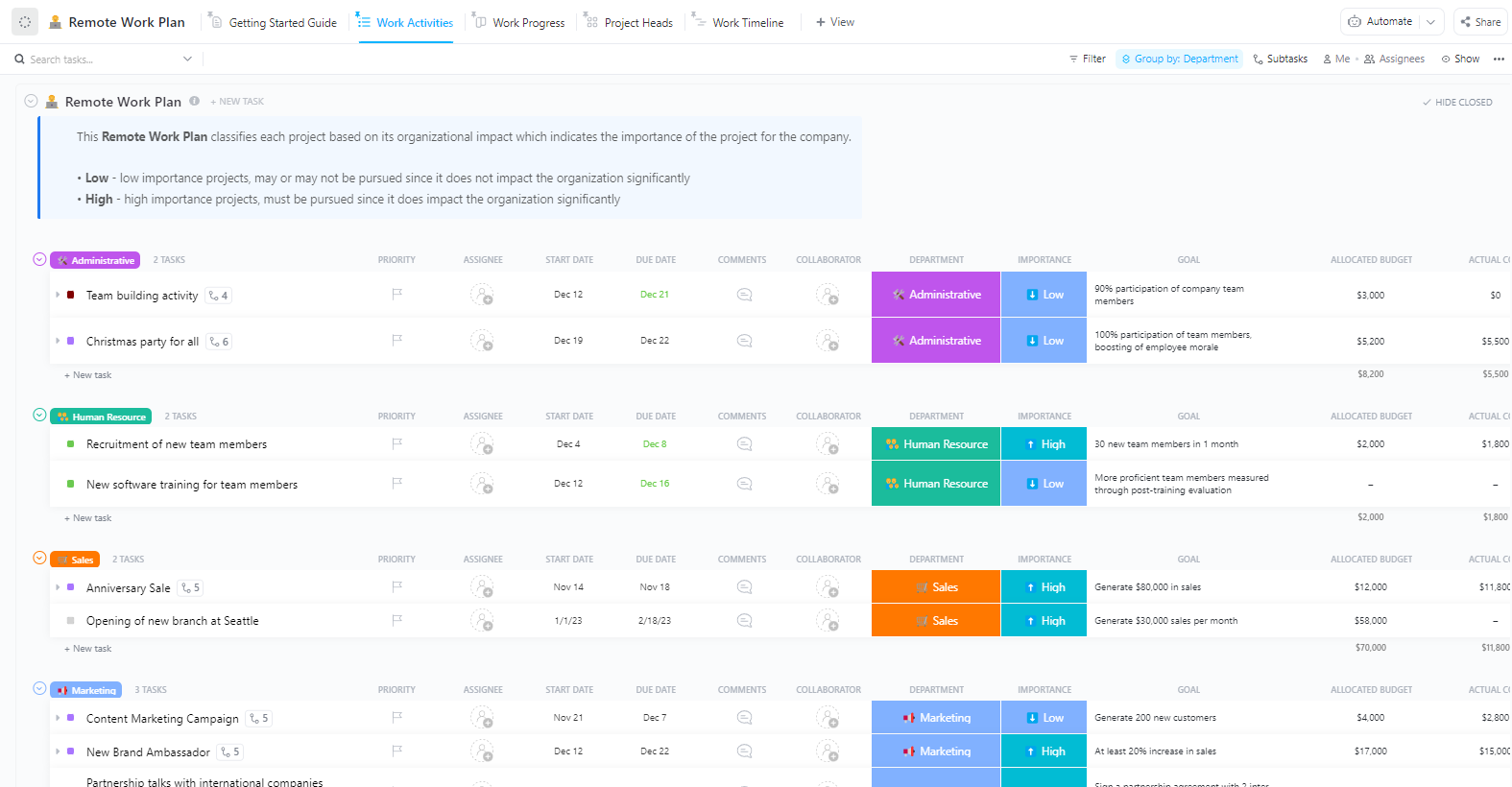Remote work is here to stay. But building a remote company culture that’s vibrant, connected, and lasting? That’s where the real magic (and challenge) begins.
Whether you’re leading a remote-first company, expanding from a hybrid model, or strengthening a fully distributed remote team, building a strong remote work culture is the key to long-term success.
And as any seasoned leader will tell you, a healthy company culture doesn’t just “happen” over video calls. It needs to be nurtured, championed, and designed with intention.
If you want your remote workers to stay connected, feel motivated, and ready to crush their goals (no matter the time zone), you’re in the right place!
Let’s dive into what makes a remote company culture work and thrive. 🚀
How to Build a Strong Remote Company Culture That Lasts
Why Remote Culture Is Critical for Distributed Teams
In a remote workplace, you can’t rely on office energy or vibes to foster a work culture. Those team lunches, quick chats by the coffee machine, spontaneous brainstorming sessions? ☕💬 In a remote environment? Not always possible.
However, without a good workplace culture, remote teams can quickly feel like a group of disconnected freelancers instead of a true team of team members. That leads to lower engagement, unclear expectations, and many “Who even is that in the Zoom meeting?” moments. 😅
Here’s why investing in remote work culture matters more than ever:
Builds trust and belonging
When remote employees feel connected to a larger company’s mission—and to each other—they show up with more energy, creativity, and loyalty. In a remote setup, company culture replaces casual office moments and keeps team members feeling connected to their purpose.
Improves communication and collaboration
A strong culture lays the groundwork for teams sharing ideas, tackling problems, and moving projects forward.
Without it, misunderstandings multiply, and collaboration across different time zones becomes chaotic without proper asynchronous work practices. It also demands necessary skills like clear writing, empathy, and thoughtful listening.
Boosts engagement and retention
🧐 Did you know? 57% of workers said they would “absolutely” look for a new job if remote work flexibility were taken away.
In today’s competitive tech industry, where tech companies constantly scout for top talent across a global talent pool, the difference between staying and leaving often comes down to remote work culture.
It drives performance
When team members feel seen, supported, and aligned with your company’s values, they don’t just perform better individually—they lift each other up.
Remote-first flexibility also benefits digital nomads, working parents, and anyone seeking work-life balance without sacrificing ambition or taking a pay cut.
A remote company culture transforms talented individuals into an unstoppable force with more influence than office perks ever could.
The takeaway? A thriving culture’s effectiveness revolves around intentional effort. It isn’t just “nice to have”—it’s a must-have for today’s workplace and your modern workplace. 🌱
📮 Insight: A typical knowledge worker has to connect with 6 people on average to get work done. This means reaching out to 6 core connections daily to gather essential context, align on priorities, and move projects forward.
The struggle is real—constant follow-ups, version confusion, and visibility black holes erode team productivity. A centralized platform like , with Connected Search and AI Knowledge Manager, tackles this by making context instantly available at your fingertips.
Challenges of Building a Remote Culture
🧐 Did You Know? Despite more flexibility, global employee engagement dipped from 23% in 2023 to 21% in 2024—the second drop since 2009.
In today’s remote work reality, top talent is no longer clustered only in Silicon Valley. Your reach across the global talent pool depends on the strength of your team culture. However, building a strong remote culture sounds inspiring, but let’s be real, it comes with its own set of hurdles.
And if you’re not prepared for them, even the best remote first companies’ well-intentioned culture initiatives can fall flat. 😬
Here’s what you’ll need to watch out for:
Limited organic connection
Without spontaneous chats or casual lunches, remote workers miss natural bonding moments. Building genuine relationships when working remotely takes deliberate effort and fun, creative team-building activities.
Communication gaps
Without face-to-face cues, tone and meaning can be lost. Asynchronous work habits aren’t just helpful but survival skills for remote teams.
Isolation and burnout
Remote work can blur working hours and personal time until it feels like you’re always on. Without strong remote work culture rituals to foster belonging and encourage work life balance, remote employees can drift into isolation—or worse, silent burnout.
Inconsistent reinforcement
If your company’s values aren’t clearly lived daily, remote employees create their own (often conflicting) rules, and team managers and leaders struggle to create unity. Without strong culture rituals, new employees may interpret the culture differently, weakening every part of the hiring process.
Lack of visibility and recognition
Without intentional systems to reinforce values and reward employees, great efforts can easily be missed, leading to increased employee turnover over time.
The good news? Every one of these challenges is solvable with the right approach—and the right tools backing you up 💪
🎉 Fun Fact: The world’s largest all-remote company, GitLab, has over 2,000 team members across 60+ countries—proving remote cultures can scale bigger than many headquarters.
Building an Awesome Remote Culture That Actually Sticks (with !)
Let’s be honest: building a strong remote company culture is more than scheduling a few virtual happy hours and hoping for the best. It’s about intentionally designing how your remote team connects, collaborates, grows, and feels supported even when everyone works across different time zones. It means rethinking old office habits and building new, digital-first ones for a workplace culture that truly lasts, distinct from a traditional co-located company.
🧐 Did You Know?: 77% of workers say they’re more productive working remotely than in an office.
So, how do you actually do it? And how can a platform like be your secret weapon for managing remote work effectively? Let’s dive in.
1. Make your company values more than just wall art
Company values should be more than a slide in your onboarding deck. In a remote company culture, they act as guideposts instead of those face-to-face moments that organically define behavior in a co-located company. Your remote culture will default to inconsistency if values are vague or invisible.
🧐 Did you know? Only 12% of executives with hybrid or remote workers planned further return-to-office mandates in early 2025. Remote-first is stabilizing, making clearly defined values even more crucial.
💡 How makes your values a daily part of work:
Build a living, breathing Culture Hub with Docs
Create a living Culture Hub using Docs. Turn values into dedicated pages with examples from real projects, team wins, or kudos. Version history ensures your company’s values evolve with your remote workplace.
Automate quarterly reminders using Automations so team leads can update examples or link values to recent Tasks. That way, your values don’t gather digital dust—they stay visible, relevant, and alive in your workflow.
✅ Result: Values aren’t a forgotten PDF—they’re a system your remote team builds together.
2. Nail your communication flow: Balancing async and sync
Remote team communication shouldn’t revolve around constant team meetings or endless video calls—especially when you have powerful remote collaboration tools that support asynchronous communication and real-time visibility.
But here’s the catch: without structure, async falls apart.
When there’s no clarity around where updates go, how fast to respond, or what deserves a meeting, async turns into silence. Context gets lost, timelines slip, and teams across time zones start to feel disconnected and out of sync.
🧐 Did you know? Poor async habits are the number one cause of remote misalignment, beating even unclear goals and tech problems.
💡 How keeps remote conversations structured, actionable, and clear:
Keep conversations focused with Chat and Catch Me Up
Use Chat for async-first, contextual conversations. Threaded replies and tagging keep communication clean, which is ideal for teams across time zones.
Coming back to a channel after a vacation or a long thread? You could scroll through dozens of messages… or use Chat’s Catch Me Up feature.
It gives you a quick summary of what happened while you were away, including:
- Your action items
- Key updates
- Any context you might’ve missed
No more backreading marathons—just the info you need, fast.
Turn conversations into action by converting Comments and Chat messages into Tasks
In , every conversation can turn into action. Spot an essential note in Chat or a suggestion in a Task Comment? Turn it into a new Task with just a click—no copy-pasting, no lost ideas. It’s a seamless way to reduce context switching, whether remote, hybrid, or desk-based.


Share async clarity visually with Clips
Instead of back-and-forth clarifications or missed instructions, record Clips to explain:
- Walkthroughs of designs
- Feedback on deliverables
- Updates to project plans
Embed Clips inside Chat threads or directly into Tasks, giving your team a visual reference that reduces confusion.
Example in Action: During Friday planning, a project lead reads Chat thread highlights via Catch Me Up, turns two discussion points into Tasks, adjusts next week’s launch timeline in Calendar, and shares a Clip explaining the new plan—all in about 10 minutes.
✅ Communication in doesn’t just stay in Chat—it flows naturally into action, visibility, and progress.
3. Build real connections, intentionally
Remote work culture doesn’t thrive on scheduled meetings alone. It needs human touchpoints—spaces for fun, team-building activities, and shared identity. The key is being deliberate: create rhythms that promote bonding while being inclusive of different working hours, personalities, and time zones.
💡 Pro Tip: Create a “Recognition Relay” challenge—every week, the last person recognized in Chat has to acknowledge someone else. It turns kudos into a fun, continuous chain reaction.
💡 How makes real connection part of daily life:
Build async bonding spaces with Chat
Launch casual channels like #pets-of-, #weekend-highlights, or #random-memes. Let teammates share asynchronously—no pressure, no scheduling stress. Before long, usernames turn into real people—and real connections.
Brainstorm fresh team rituals with AI
Need fresh team-building ideas? Let AI help.
Get suggestions tailored to your team’s style—then turn them into actionable tasks.
✨ Ideas you can try:
- Async scavenger hunts
- Photo challenges
- Introvert-friendly virtual hangouts
- Weekly wins shoutouts
📌 Next step:
Convert ideas into Tasks, assign owners, and track participation—zero extra stress, all the fun.
Example in Action: The team launches a casual Bingo-style photo thread after AI suggests an async “Show Your Weekend” challenge. Pets, snacks, beach trips, and hobbies flood the Chat—building personal connections across time zones.
✅ Strong teams aren’t built by accident—they’re built by making space for real moments, inside the workflows that matter.
🧐 Did you know? Hybrid workers experience the lowest burnout (28%), compared to fully remote (36%) and entirely onsite (35%) employees.
Meaning: Regular virtual bonding can reduce burnout even for fully remote teams!
4. Shine a spotlight on wins (big and small!)
Recognition drives motivation—especially in remote teams. Celebrating wins, big or small, keeps momentum going, builds connection, and strengthens culture. But it takes more than a 🎉 emoji.
For recognition to really land, you need systems that make it visible, consistent, and supported from the top down.
🧠 Remember: You’re building a place where people feel safe to be seen, heard, and celebrated—what many call the foundation of a strong people experience strategy. 🏆
💡 How makes recognition visible and actionable:
Track wins with Goals
In a remote company culture, people can easily feel invisible—especially when their contributions aren’t seen or acknowledged in real time.
With Goals, you can set, track, and celebrate achievements across individuals, teams, or departments. Create culture-driven goals like “Shout out 10 wins per sprint” or “Recognize every new hire within week one.” Link those Goals directly to Tasks or Chat threads where the recognition happened.
As the Goal progress updates, your team sees exactly how they’re moving the needle—not just on delivery, but on values and collaboration too.
💡 Pro Tip: Tag Tasks or comments with your company values (like #customer-obsession or #team-first) to automatically contribute to culture Goals.
✅ Result: Recognition becomes measurable, meaningful, and something everyone contributes to—not something that relies on memory or mood.
🧐 Did you know? Only 30% of hybrid managers have been formally trained in leading distributed teams.
Meaning: Intentional feedback systems (like pulse surveys) matter even more for closing leadership gaps.
Automate recognition so that oversight does not compromise remote culture
You can also set up Automations to make recognition effortless and consistent. Trigger a congratulatory message in Chat the moment a major milestone is completed or a goal is reached. Update a “Team Wins” Doc automatically when someone wraps a complex cross-team project or earns glowing feedback from a customer.
Encourage casual appreciation with a #Kudos Chat Channel
Take it a step further by creating celebration channels in Chat—like #Kudos, #SmallWins, or #GratitudeWall—where recognition becomes a daily part of your remote work culture, not a quarterly ritual.
- Drop quick thank-yous after successful handoffs
- Celebrate above-and-beyond efforts
- Highlight small wins that matter
Because when your team sees how their impact is valued, not just delivered, they’re more likely to bring their best again tomorrow.
Example in Action: Every kudos posted in Chat tagged #customer-obsession triggers an update in the Recognition Dashboard and counts toward the quarterly “Highlight Core Values 50 Times” Goal—turning shoutouts into real cultural data.
✅ Recognition isn’t random—it’s strategic, visible, and part of your everyday rhythm with .
5. Build that trust factor: Psychological safety is key
Trust isn’t just warm fuzzies—it’s the foundation of real collaboration. Remote employees need to feel safe asking questions, admitting mistakes, and giving feedback without fear.
💡 How makes feedback, action, and trust part of your culture:
Collect honest feedback with anonymous Forms
Trust starts when people feel safe to speak up. Use Forms to collect:
- Anonymous pulse surveys (“How supported do you feel this month?”)
- Quarterly feedback on team processes
- Suggestions for culture improvements
- Input on project handoffs, communication rhythms, and leadership support
Forms are fully customizable—adjust questions, visibility, and structure to match the tone you want. You can even automate follow-up tasks based on form submissions so that action happens automatically.
Best part? You can link Forms inside Docs, Task descriptions, or share them asynchronously via Chat—no awkward “mandatory survey” emails needed.
💡 Pro Tip: Don’t just survey satisfaction—survey belonging. Ask, “When was the last time you felt especially proud to work here?” and build from those moments.
Act on trust with structured 1:1 Check-In Meeting Templates
Building trust starts with listening—and acting on it. Use 1:1s to uncover blockers, feedback, and growth goals.
Ask things like:
- “What’s blocking your best work?”
- “Getting enough focus time?”
- “What’s one thing we could improve?”
Schedule recurring 1:1 Tasks, keep them private, and track trends—without losing the human touch.
Respect privacy while maintaining visibility with Workload and Activity Views
Use Activity View to monitor project engagement gently, not invasively. Use Workload View to spot when teammates are nearing burnout loads before they escalate.
Visibility that helps, without becoming surveillance.
Example in Action: After an anonymous Form surfaces concerns about work overload, a team lead checks Workload View, confirms the signal, uses AI to generate a few follow-up questions, and adjusts priorities during 1:1s—closing the loop visibly and respectfully.
✅ Trust is built when feedback isn’t just collected—it’s acted on, learned from, and visible in how you lead day-to-day.
💡 Pro Tip: Before gathering feedback, remind your team that sharing honestly isn’t just safe—it’s a key way they shape the culture. Framing feedback as a cultural contribution can boost participation!
6. See what’s happening: visibility and tracking matter
In a remote work culture, you can’t rely on passive awareness. Visibility into workstreams, goals, and well-being creates alignment and prevents burnout before it starts.
💡 How gives you actionable, people-first visibility:
Build holistic Dashboards that combine productivity and culture
You don’t need to hover to stay informed. You need the right lens. Views give teams and managers the flexibility to see what matters without chasing updates.


- Use Board View to watch projects move from “To Do” to “Done”
- List View to manage onboarding or daily work
- Calendar View for launches, content schedules, or rituals
- Workload View to check capacity and prevent burnout
Choose the right View depending on what you need to manage
Example in Action: Before assigning Tasks for a new client project, a PM checks Workload View to avoid overload, Calendar View to map deadlines, and uses a custom Dashboard widget to track kickoff milestones, making sure work doesn’t just get done, but gets done sustainably.
✅ In , visibility isn’t just about deadlines—it’s about designing smarter, healthier ways to work together.
7. Smooth out the wrinkles: seamless workflows rock
Messy workflows create mental overhead and hurt your remote culture. Clean, integrated workflows = happier remote workers.
💡 How makes workflows effortless and scalable:
Eliminate repetitive busywork with powerful Automations
Automations don’t just save time—they clean up your entire workflow.
Automate routine actions like:
- Moving a Task to “Review” when a linked GitHub pull request closes
- Reassigning a Task when a due date passes without completion
- Updating priorities when blockers are tagged in Chat
- Automatically reminding a project owner when dependencies aren’t completed
Automations can even trigger multiple actions from a single event, like sending a Slack message, updating a Custom Field, and moving a Task to the next stage, all at once.
The result? Less task-hopping, more focus, and no critical steps slipping through the cracks.
Connect your tool stack seamlessly with Integrations
Your team doesn’t live in one app, and your workflows shouldn’t either.
’s native integrations with Slack, Zoom, GitHub, Google Drive, and more let you:
- Turn Slack messages directly into Tasks
- Attach Zoom meeting links to Tasks automatically
- Sync project documents across and Drive
- View GitHub PR statuses inside related Tasks
Fewer tabs. Less toggling. More flow.
With Automations + Integrations working together, you’re not just managing work but designing an effortless ecosystem.
Example in Action: After noticing Tasks stuck in “Review” for over a week, a project lead prompts AI to identify common patterns, updates Automations to escalate after 48 hours, and syncs GitHub statuses automatically—cutting review times by 40%.
✅ In , seamless workflows don’t happen by accident—they’re built intentionally with the right tools and connected intelligently.
8. Start Strong: Nail your remote onboarding
First impressions shape culture. A great remote onboarding process doesn’t just help new employees settle in—it sets the foundation for employee retention.
💡 How makes onboarding consistent, human, and scalable:
Launch a structured, repeatable onboarding journey with Templates
Use the Remote Work Plan Template or customize your onboarding Template:
- Pre-fill key Tasks like setting up tools, completing training modules, and scheduling intro meetings
- Link directly to important Docs like the Culture Hub, Work From Home guidelines, and async norms
- Include Custom Fields to track onboarding progress and well-being scores
Every new hire starts from a consistent foundation, and managers aren’t always recreating the wheel.
💡 Pro Tip: 🎥 Record Welcome Videos with Clips
Use Clips to introduce the team, give a quick tour of the workspace, or walk through the first 30 days. Embed them directly into Tasks or Docs so new hires feel welcomed and informed—even before their first call
Example in Action: A new marketing hire starts Day 1 by opening a Welcome Task linked to their personalized Timeline. They watch a welcome Clip, read the Culture Doc, check off first-week milestones, and submit feedback via form on Day 14—giving both them and HR a clear, connected onboarding experience.
✅ In , remote onboarding isn’t paperwork—it’s the foundation for belonging, success, and long-term engagement.
Real Examples of Remote Culture in Action
The best remote cultures don’t happen accidentally—they result from intentional systems, daily habits, and strong leadership support.
💬 Feel-Good Boost:
The culture you’re shaping today might be why someone feels excited to log in tomorrow. That’s something worth smiling about.
Let’s take a look at how real remote-first companies with a growth mindset build thriving cultures across screens and continents:
GitLab: Document Everything, Trust Deeply
As one of the largest remote companies in the world, GitLab treats documentation not just as an internal resource, but as a company cultural pillar.
Every decision, process, and value lives inside their public Handbook—making transparency a daily practice, not a buzzword.
Instead of relying on memory or hallway conversations, GitLab empowers every team member to find answers, suggest improvements, and contribute to the evolving culture.
✨ Lesson for you:
Remote teams thrive when documentation isn’t seen as extra work—it’s seen as the foundation for a strong remote work culture and autonomy.
Remote.com: Celebrate Connection, Not Just Completion
At Remote.com, leadership intentionally celebrates cross-cultural team wins, not just final product launches or quarterly KPIs.
Recognition is baked into the rhythm of work, not tacked on after it.
Small wins are made visible through async shoutouts, and employees are encouraged to nominate peers for demonstrating company values rather than just hitting goals.
✨ Lesson for you:
In a remote setup, visibility of effort is just as important as visibility of results. Recognition strengthens emotional connection to the team and the mission.
Buffer: Prioritize Psychological Safety at Scale
Buffer operates with complete salary transparency, open values, and mental health check-ins.
Leaders normalize vulnerability by actively hosting feedback sessions—even when uncomfortable.
By treating psychological safety as an ongoing system, Buffer creates a space where honest conversations about balance, burnout, and growth are the norm.
✨ Lesson for you:
Remote workers need cultural systems that normalize honesty, feedback, and emotional support, not just formal reviews.
Zapier: Automate the Boring, Celebrate the Human
Zapier doesn’t just automate workflows for efficiency—it automates culture, too.
When new hires complete onboarding, Zapier triggers welcome celebrations automatically.
When projects hit milestones, public celebrations fire off across team channels, keeping momentum high without relying on manual nudges.
✨ Lesson for you:
In today’s remote-first world, automating celebrations ensures team wins don’t get lost in busy calendars—and everyone feels seen.
Culture Isn’t Built by Proximity—It’s Built by Design
Building a fantastic remote company culture is an ongoing process—not something that happens by chance. Remote employees don’t rely on office proximity to feel connected; they rely on systems built with intention. isn’t just a project management tool—it’s the operating system where a thriving culture is designed, nurtured, and scaled.
helps you reinforce your company’s values, build scalable rituals for future hires, and establish lasting communication habits with the help of communication plan templates. It also reduces employee turnover, and keeps new teammates thriving toward your north star. It transforms good intentions into sustainable practices that drive employee retention, strengthen remote employees’ engagement, and build a long-lasting workplace culture.
Most importantly, provides the structure your remote company needs to reinforce its values as it grows consistently. This helps you create a resilient, connected, and high-performing organization ready to lead in the future of remote work.
Sign up with for free today!


Everything you need to stay organized and get work done.














